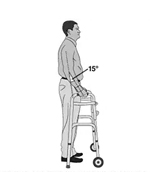Isn’t it strange? Nothing is ever as easy as it looks. Using a walker correctly is certainly a prime example. Regardless of what you may think as the person looking on, it’s just not as intuitive as it looks. Like many things, it takes a little time, patience – and practice.
There are a few additional considerations that can help make the process more natural – and safer. Which is important, because using a walker incorrectly can actually increase fall risk and body ache, which is the last result you want! You want the user to feel secure and confident about their device. So, it’s important we get the basics right, then comfort, safety and increased independence will follow.
1. SETUP | First things first
While using a walker doesn’t come naturally, having the correct setup makes a substantial difference to your ease of adaption.
A walker should be personal. Correctly set up to fit your height. An incorrectly set up walker increases body stress and increases the risk of falls. A correctly set up frame reduces the risk of a fall and reduces stress on the shoulders and back as you walk.
Your walker’s set-up should ideally be done by the experts. We would obviously recommend that your walker is set up by your service provider. If this has not happened, and you are struggling, we do offer the service, so you are welcome to give us a call or drop us a mail.
Necessity is however the mother of many things, so if you need to do it yourself, you will need a second set of eyes and hands, a friend who is willing and able to assist.
The process is simple.
The “driver” will need to step inside the walker and stand with their shoulders relaxed and hands on the grips. Arms should hang relaxed at their sides, elbows bent comfortably at about 15 degrees. The top of the walker should line up with the crease on the inside of their wrist.
And that’s it.
That’s your perfect height.
Lock your walker in place – and you’re done!
2. PERFORMANCE | How to use a walker correctly
In a recent study released by the Center For Disease Control, of the falls related to walkers and canes, you may be surprised to learn that most—87% of elderly falls—were attributable to walker use. Verywellhealth.com Specifically, incorrect walker use.
There are 4 easy steps to using a walker correctly:
It will feel unnatural in the beginning. Awkward. But, persevere. Used correctly, safety, efficiency, and independence are the guaranteed result.
- Stand with both feet within the frame of the walker and firmly grip the side grips of the walker
- Depending on your type of walker, you will either glide your walker forward and then step back into its frame OR
you will lift the walker and place it about 2 inches forward and then again, step back into its frame.It’s important to take small steps while using a walker.
- Step forward with your WEAKER leg first.
Don’t step all the way to the front. Just step comfortably, placing your foot down in the middle area of the walker. - As you step the other leg forward, your body weight should push straight down on the walker handles – not forward. Don’t push forward because that can cause the walker to slide unexpectedly.
Keep the walker close to you.
Place it no more than arm’s length in front of you at all times. - Look forward (not at your feet) when using the walker.
3. RESTING | How to safely sit or stand when using a walker
RULE 1: Do NOT use the walker to help you sit or stand.
Why?
RULE 2: NEVER PUT YOUR FULL WEIGHT ON A WALKER – It’s not meant for that
These are common mistakes. Instinct is to grab the walker for security – but that is not its function.
The walker is an assistive aid.
To sit down:
- Back up until your legs touch the chair.
- With one hand on the walker, use the other hand to reach down towards the arm of the chair.
- Once you have a grip on that – release the walker and place your other hand on the other arm of the chair,
- Slowly lower into the chair, using the chair arms for support if needed.
To stand up:
- Never use the walker to pull yourself up from a seated position because it can tilt and cause you to lose your balance. Instead, push yourself up using the arms of the chair and only put your hands on the walker when you are almost fully standing.
4. GENERAL DO’S AND DON’TS
DO
-
Stand upright to protect your back. Don’t hunch over!
-
Look straight ahead when walking.
-
Always step into the walker, rather than walking behind it.
-
Change directions slowly, taking small steps.
DON’T
-
NEVER use the walker to pull yourself up from a sitting position.
-
Do NOT use the walker to help you sit or stand.
-
NEVER put your full weight on the walker.
-
Push the walker too far in front of you. It must always be in easy reach.
If you have any questions or concerns related to your walker, give us a call or drop us a mail.
We are here to help.


